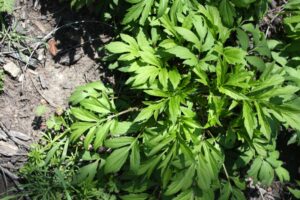By DR. DAVID COZZO
RTCAR
Sochan, also known as green-headed coneflower or cutleaf coneflower, is an herbaceous perennial in the sunflower family. In late summer and fall, it sends up a tall flowering stalk; the yellow, daisy-like flower having a green center instead of the typical brown center. But, the interest is not in the stalk or the flowers, but in the young greens. Those fresh, tender greens are one of the earliest spring wild foods and were a highly nutritious addition to the diet after a winter of stored foods.

Sochan, also known as green-headed coneflower or cutleaf coneflower, is an herbaceous perennial in the sunflower family. (Photo courtesy of Dr. David Cozzo/RTCAR)
How nutritious is sochan? Perhaps the best way to demonstrate how good it is would be to compare it to the nutritional superstar kale. When it comes to vitamins and minerals, sochan is not quite as strong in the vitamin category, but is comparable or better in the mineral department. Sochan provides about 45% of the recommended daily allowance (RDA) of Vitamin A per 100 grams (about 3 ½ ounces), while kale has a whopping 300 percent. While this may seem low for sochan, it is still about four times the amount found in 100 grams of iceberg lettuce. Kale also provides about 89 percent of the RDA for Vitamin C, while our sochan sample only had about 4 percent. Other research has shown that the Vitamin C content changes over the growing season, so the limit of testing at one time during the year might have missed the peak content for Vitamin C. Sochan does have nearly twice the folic acid content of kale, providing nearly 15 percent while kale only contains about 7 percent of the RDA.
Sochan really comes into its own when considering its mineral content. It has five times the manganese, twice the zinc, and more phosphorous and copper than kale. It also contains just about as much magnesium, iron, calcium and potassium. All this and only 35 calories per 100 grams! (Kale contains 50 calories, but no one is going to blow their diet by eating too much of either.) If you can cut out the bacon grease, sochan is a heart healthy food with 0 grams of cholesterol.
Sochan is usually picked in the wild and grows best along creeks and rivers. But concern over loss of habitat and access to traditional harvesting areas has made it harder to come by. There is also concern that if sochan gains popularity wild populations will be overharvested, much like what is happening with ramps. However, growing sochan is so easy that this should never be a problem. Test plots at the Cherokee Central School developed by Joe-Ann McCoy of the NC Arboretum Germplasm Repository demonstrated just how easy it is to grow sochan. Plants grown from seeds for one year and two years all survived in the test plots. So did plants produced by crown divisions. Even plants that were transplanted whole without dividing had an 85 percent survival rate. If you have a partially to fully shaded spot near your house and can find some young plants, you can have your own sochan patch. It is easy to grow, tasty, and nutritious!





